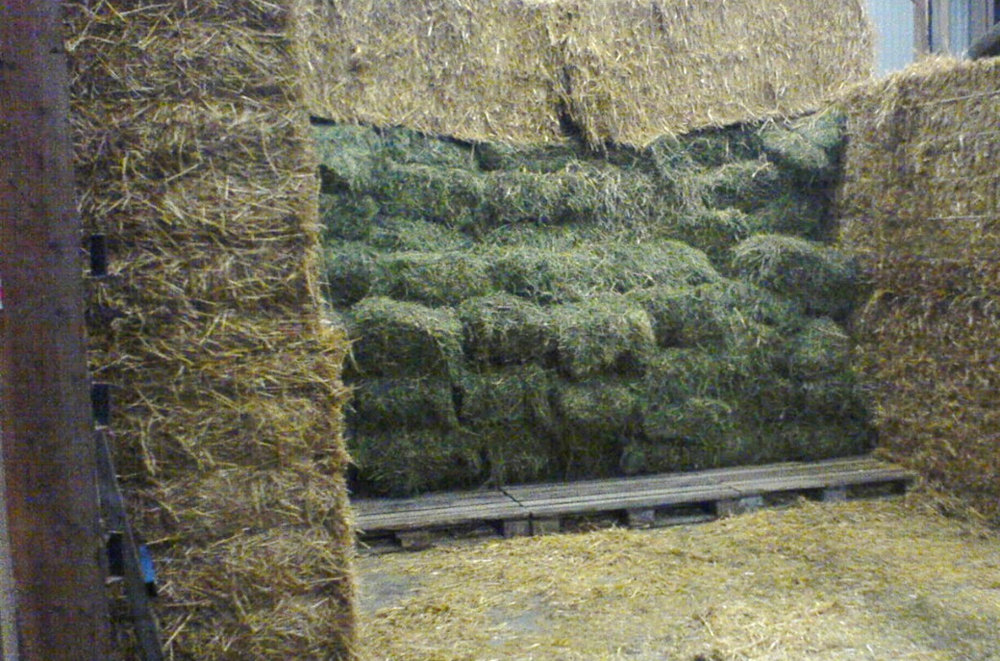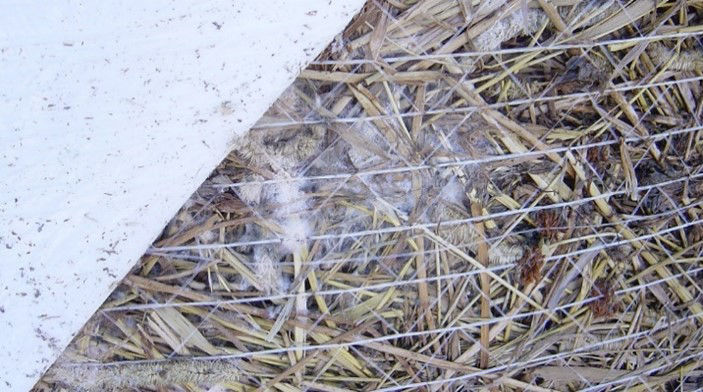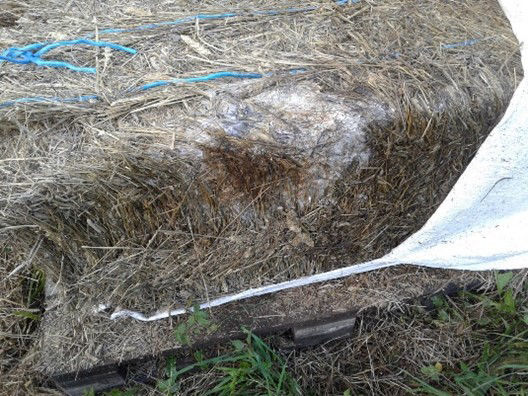Moulds and mycotoxins are undesired in feeds and forages as they can cause irreparable damage to both the horse and human. Moulds produce spores which are associated with the development of chronic airway diseases, such as equine asthma (Riihimäki, 2008), and can also cause fungal infections, such as aspergillosis (Tell, 2005).
Mycotoxins are secondary metabolites produced by moulds. They can severely affect horse health, and consequently maximum permitted limits are provided in feed legislation (EFSA, 2004). Below are some examples of mycotoxins with detrimental effects on horses, however many more mycotoxins exist, but for most of them there is a scarcity of knowledge of their effects on horses and other animals.
- Fumonisin B1 which causes leukoencephalomalacia, a deadly neurologic disease
- T2-toxin which causes oral ulceration
- Zearalenone which is associated with reproductive disorders (Caloni and Cortinovis, 2010)
- Aflatoxins which cause liver failure and in some cases death (Schurg and Noon, 1979; Scudamore and Livesey, 1998; Gallo et al. 2015).
If present moulds and mycotoxins cannot be removed from the feed and mouldy forage should never be used for feeding any animal. Prevention of moulds in forages is therefore a key issue, as well as how to detect moulds in the forage if suspected.
Mould categorisation
Moulds in feeds are often categorised into two main groups: field fungi, and storage fungi. Field fungi are present on the standing crop and usually consist of genera such as Cladosporium, Alternaria and Fusarium, but other genera or species can also be present. Although these genera are often primarily regarded as a problem for plant growth and grain quality in cereals, they may also pose a threat to equine health due to formation of mycotoxins in the standing grass crop. Fusarium mycotoxins have been found in silage (Driehuis, 2011), hay (Buckley et al. 2007) and haylage (Schenck et al. 2019).
Storage fungi, such as Penicillium, Aspergillus and Wallemia species, develop during improper storage of harvested feeds, where both spores and mycotoxins may cause health issues in horses (Scudamore and Livesey, 1998; Samson et al. 2010; Gallo et al. 2015). Both Aspergillus and Penicillium species, and their mycotoxins, have been found in silage (Skaar, 1996; O’Brien et al. 2007, 2008; Driehuis, 2011; Wambacq et al. 2016) and haylage (Schenck et al. 2019), in addition to Wallemia sebi in hay (Sundberg et al., 2008).
Preventing mould growth through understanding forage conservation principles
To prevent growth of moulds in forages it is important to understand the basics of different forage conservation methods. Forage for horses is commonly conserved as hay or haylage. Hay is conserved by drying, whereas haylage is conserved by semi-drying and anaerobic storage (Müller, 2018).
NOTE – Anaerobic storage is storage in an oxygen free environment. Aerobic storage is storage in an environment with oxygen present.
Hay
Hay is conserved through removal of water to a sufficiently low dry matter content (at least 85%). Providing it is sufficiently dry at harvest hay can be stored aerobically, but it must be kept dry during the entire storage period. Dry hay is hygroscopic, meaning if it is stored in a moist environment it will absorb water and then becomes a perfect substrate for mould growth. Moulds grow quickly in insufficiently dry hay and the spores can cause chronic respiratory diseases in both horses and humans.


Figure 1. The white “smoke” in the centre of the photo are mould spores. Moulds grow quickly in insufficiently dry hay. The spores may cause chronic respiratory diseases in both equines and humans. IMPORTANT - Do not handle mouldy hay without a protective breathing mask and never feed such hay to any animal. Photo: C. Müller
As moulds are aerobic (need oxygen to be able to grow) and also need moisture to be able to grow in hay, moist winter climates with temperatures above 0oC are risky environments for hay storage. It is necessary to protect the dried hay during wintertime to avoid moisture absorption and mould growth in the top and outer layers of the hay batch (Sundberg et al. 2008). The easiest and most effective way to protect the hay is to cover it with straw bales, which creates a barrier between the hay and the moist air.

Figure 2. Hay stored in a simple uninsulated barn, protected from moist air using straw bales surrounding the hay batch. Wooden pallets on the floor have been used to provide an air space and avoid moisture from the concrete floor to travel upwards into the hay. Credit: C. Müller.
Haylage
Haylage has a dry matter content of between 50 – 85% and haylage conservation relies mainly on air-tight storage for avoidance of mould growth (Müller, 2018; Schenck, 2019). Haylage is therefore wrapped in plastic layers, and it is important to use a sufficiently high number of stretch film layers when wrapping the bales. The higher the dry matter content, and the more mature the crop is at harvest, the higher the requirement of the number of stretch film layers to avoid punctures and subsequent mould growth (Paillat and Gaillard, 2001; O’Brien et al. 2007, 2008; Keles et al. 2009; Schenck et al. 2019). Haylge with a higher dry matter has recently been reported to increase the risk of finding moulds in general and Fusarium mycotoxins in the forage (Schenck et al. 2019).




Figure 3. Visible fungal growth on the surface of wrapped bales are a tell-tale sign that the wrappings have not been air-tight, as these fungi are aerobic (needs oxygen to be able to grow). Credit: C. Müller
A recent report from Germany found that haylage samples with a dry matter over 70% had higher mould counts compared to haylage with a dry matter of 50 – 70%. In the same study, haylage samples with dry matter contents >70% were also positive for Aspergillus detection more often compared to haylage samples with dry matter contents between 50 – 70% (Intemann et al. 2022). A general recommendation for haylage is therefore to not exceed 70% dry matter.


Figure 4. Wrapped bales need to be handled with care to avoid punctures in the wrappings, in order to prevent mould growth. Store round bales on their flat end. Credit: C. Müller.
Wrapped bales should be carefully handled and stored to avoid punctures in the wrapping and should be protected from birds and wildlife during the storage period. Round bales should be stored on their flat ends, as there is a higher number of stretch film layers there.
Detection and analysis of moulds and mycotoxins
A sensory examination of the forage is often the first step in evaluating its hygienic quality. This includes to visually inspect the forage, smell it and examine its structure. There should be no visible mould, the smell should be fresh and not dusty, musty or mouldy, and the forage should have a clear structure without lumps or a slimy touch.
Laboratory analysis of microbial load and mycotoxin presence in forage can be performed at several feed laboratories and will provide more information about the hygienic quality of the forage. A sensory examination cannot replace a microbial analysis, but studies have shown that there is a good agreement between the results of a sensory examination and a microbial analysis of moulds in haylage (Intemann et al., 2022). This means that if a careful inspection of haylage is performed and the haylage is judged as having a good hygienic quality there will be a high probability that a laboratory analysis of moulds will give the same result (Intemann et al., 2022). However, if the inspection gives reason to doubt the hygienic quality of the forage, a laboratory analysis will most likely confirm it. Visible moulds in hay and wrapped forages (and other feeds) are a sign that the conservation of the forage has not been optimal, and care should always be taken to not feed mouldy feeds to horses, or any other animals, considering the risks of severe disease that are associated with it.
This article was originally published on 29th October 2022. It was written by Cecilia E. Müller, PhD, Department of Animal Nutrition and Management, Swedish University of Agricultural Sciences, Uppsala, Sweden. It was updated on 9th October 2023 by Rachel Cowden MSc RNut.
References
- Buckley, T., Creighton, A. and Fogarty, U. (2007). ‘Analysis of Canadian and Irish forage, oats and commercially available equine concentrate feed for pathogenic fungi and mycotoxins’, Irish Veterinary Journal, 60, pages 231-236.
- Caloni, F., and Cortinovis, C. (2010). ‘Review: Effects of fusariotoxins in the equine species’, The Veterinary Journal, 186, pages 157-161.
- Driehuis, F. (2011). ‘Occurrence of mycotoxins in silage’, In: Proceedings of the II International Symposium on Forage Quality and Conservation, 16th-19th November 2011, Sao Paolo, Brazil.
- EFSA (2004). ‘Opinion of the scientific panel on contaminants in the food chain on a request from the commission related to deoxynivalenol, (DON) as undesirable substance in animal feed’, EFSA Journal, 73, pages 1-42.
- Gallo, A., Giuberti, G., Frisvad, J.C., Bertuzzi, T, and Nielsen, K.F. (2015). ‘Review on mycotoxin issues in ruminants: Occurrence in forages, effects of mycotoxin ingestion on health status and animal performance and practical strategies to counteract their negative effects’, Toxins, 7, pages 3057-3111.
- Inteman, S., Reckels, B., Schubert, D., Wolf, P., Kamphues, J. and Visscher, C. (2022). ‘The hygienic status of different forage types for horses- A retrospective study on influencing factors and associations with anaemnestic reports’, Veterinary Sciences, 9, page 226.
- Keles, G., O'Kiely, P., Lenehan, J.J. and Forristal, P.D. (2009). ‘Conservation characteristics of baled grass silages differing in duration of wilting, bale density and number of layers of plastic stretch-film. Irish Journal of Agricultural and Food Research’, 48, pages 21-34.
- Müller, C.E. (2018). ‘Silage and haylage for horses, Review paper’, Grass and Forage Science, 73, pages 815-827.
- O’Brien, M., O'Kiely, P., Forristal, P.D. and Fuller, H. (2007). ‘Visible fungal growth on baled grass silage during the winter feeding season in Ireland and silage characteristics associated with the occurrence of fungi’, Animal Feed Science and Technology, 139, pages 234-256.
- O’Brien, M., O´Kiely, P., Forristal, P.D., & Fuller, H.T. (2008). ‘Fungal contamination of big-bale grass silage on Irish farms: predominant mould and yeast species and features of bales and silage’, Grass and Forage Science, 63, pages 121-137.
- Paillat, J.M. and Gaillard, F. (2001). ‘PA, Precision Agriculture: Air-tightness of wrapped bales and resistance of polythene stretch film under tropical and temperate conditions’,. Journal of Agricultural Engineering Research, 79, pages 15-22.
- Riihimäki, M. (2008). ‘Inflammatory response in equine airways’, Doctoral thesis no. 12/2008. Swedish University of Agricultural Sciences, Uppsala, Sweden.












